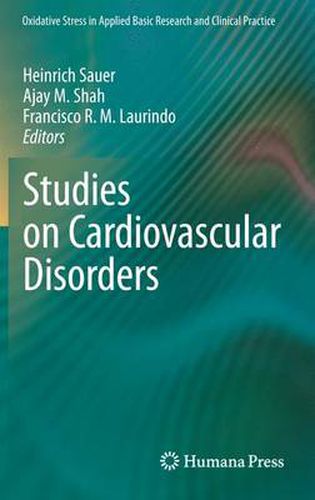Readings Newsletter
Become a Readings Member to make your shopping experience even easier.
Sign in or sign up for free!
You’re not far away from qualifying for FREE standard shipping within Australia
You’ve qualified for FREE standard shipping within Australia
The cart is loading…






This title is printed to order. This book may have been self-published. If so, we cannot guarantee the quality of the content. In the main most books will have gone through the editing process however some may not. We therefore suggest that you be aware of this before ordering this book. If in doubt check either the author or publisher’s details as we are unable to accept any returns unless they are faulty. Please contact us if you have any questions.
The role of reactive oxygen species (ROS) in the cardiovascular system is Jan- faced. Whereas low concentrations of ROS are involved in variety of physiological signalling events, oxidative stress resulting from deregulated overproduction of ROS and/or impaired antioxidant defences contributes to cardiovascular disease. The actions of ROS in the cardiovascular system are a fascinating topic, not only for the basic science researcher but also for the clinician who is interested in seeking new therapies for his patients suffering from cardiovascular disease. The current book provides a comprehensive overview of the molecular mechanisms and pathoph- iological settings in which chronic and detrimental oxidative stress arises within the heart and vasculature. The book also considers currently discussed strategies in avoiding chronic redox stress resulting from exposure to risk factors or various cardiovascular interventions. The series starts with an overview by Denise de Castro Fernandes, Diego Bonatto and Francisco Laurindo of redox signaling models that could underlie the dev- opment of redox-associated cardiovascular disorders. The interactions of proteins within signalling cascades with ROS and the regulation of such interactions by the anti-oxidative capacity of the cell are discussed. Rebecca Charles, Joseph Burgoyne and Philip Eaton report on redox-mediated modi cations of proteins under ph- iological and pathophysiological conditions and the variety of post-translational oxidative modi cations that explain redox sensing and signal transduction by proteins at the molecular level. ROS are generated during embryogenesis and may be involved in the proper development of the cardiovascular system.
$9.00 standard shipping within Australia
FREE standard shipping within Australia for orders over $100.00
Express & International shipping calculated at checkout
This title is printed to order. This book may have been self-published. If so, we cannot guarantee the quality of the content. In the main most books will have gone through the editing process however some may not. We therefore suggest that you be aware of this before ordering this book. If in doubt check either the author or publisher’s details as we are unable to accept any returns unless they are faulty. Please contact us if you have any questions.
The role of reactive oxygen species (ROS) in the cardiovascular system is Jan- faced. Whereas low concentrations of ROS are involved in variety of physiological signalling events, oxidative stress resulting from deregulated overproduction of ROS and/or impaired antioxidant defences contributes to cardiovascular disease. The actions of ROS in the cardiovascular system are a fascinating topic, not only for the basic science researcher but also for the clinician who is interested in seeking new therapies for his patients suffering from cardiovascular disease. The current book provides a comprehensive overview of the molecular mechanisms and pathoph- iological settings in which chronic and detrimental oxidative stress arises within the heart and vasculature. The book also considers currently discussed strategies in avoiding chronic redox stress resulting from exposure to risk factors or various cardiovascular interventions. The series starts with an overview by Denise de Castro Fernandes, Diego Bonatto and Francisco Laurindo of redox signaling models that could underlie the dev- opment of redox-associated cardiovascular disorders. The interactions of proteins within signalling cascades with ROS and the regulation of such interactions by the anti-oxidative capacity of the cell are discussed. Rebecca Charles, Joseph Burgoyne and Philip Eaton report on redox-mediated modi cations of proteins under ph- iological and pathophysiological conditions and the variety of post-translational oxidative modi cations that explain redox sensing and signal transduction by proteins at the molecular level. ROS are generated during embryogenesis and may be involved in the proper development of the cardiovascular system.